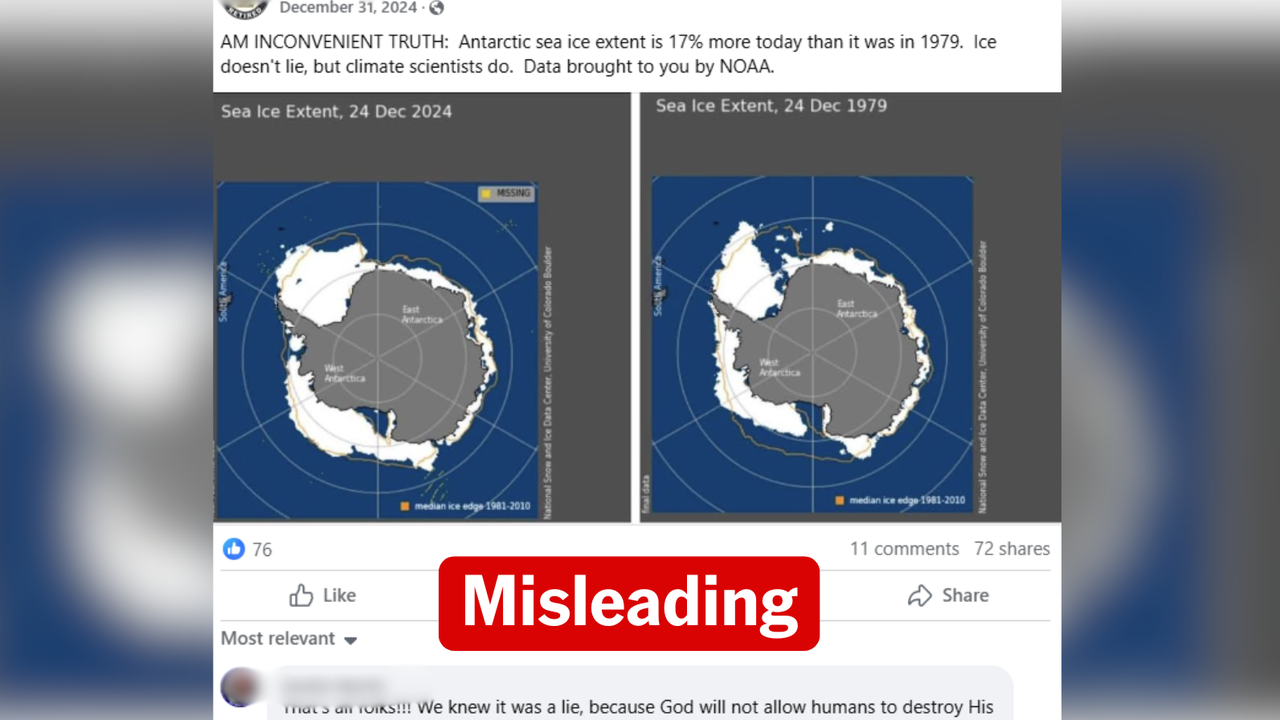WHAT WAS CLAIMED
Antarctic sea ice extent is 17 per cent higher today compared to 1979.
OUR VERDICT
Misleading. The claim cherry-picks dates and ignores long-term trends.
AAP FACTCHECK - A misleading claim about Antarctic sea ice, based on data from two specific days decades apart, is being erroneously used to suggest climate change is a hoax.
Experts say short-term data is highly variable and long-term observations are needed to show trends.
The claim can be traced back to an X post from December 26, 2024.
"Antarctica sea ice extent is 17% higher today than it was in 1979," its caption reads.
"Ice doesn't lie, but climate scientists do."
One Facebook user captioned their post: "More proof of the hoax."

Dr Petra Heil, a sea ice scientist at the Australian Antarctic Program, said sea ice extent refers to the total horizontal area of the ocean surface that is at least 15 per cent covered by sea ice.
The 15 per cent figure is used because it provides a consistent way to define the edges of ice when using satellites, she explained.
According to a daily figures dataset from the National Snow and Ice Data Center (NSIDC), sea ice extent on December 24, 1979, was 6.842 million square kilometres, while on December 24, 2024, it was 8.018 million square kilometres (tab SH-Daily-Extent).
Comparing these two specific dates, it is true to say that December 24 in 2024 was about 17 per cent higher than the same day in 1979.
However, NSIDC data also shows that December was the only month in 1979 that had days on which sea ice extent was lower than in 2024.
Caroline Holmes, a polar climate scientist at the British Antarctic Survey, told AAP FactCheck the claim being made on social media was extremely misleading.
"Comparing values on individual days in this way is picking data to fit a false narrative, because sea ice naturally varies a lot on timescales from days to years," Dr Holmes said.
Dr Heil also said day-to-day measurements are affected by weather, wind stress, waves and tides.
Long-term data is required to understand trends in Antarctic sea ice extent, experts said.
James Screen, a climate science expert at the University of Exeter, said there had been little change in the Antarctic - even a slight increase - until the last decade, when large losses were observed.
"Scientists are actively trying to understand if the sudden decline (post-2016) represents the emergence of a climate change signal in the Antarctic or if it is a very rare manifestation of natural variability," Professor Screen said.
"Most likely, in my opinion, it is some combination of the two.
"But one thing's for sure, you cannot conclude anything related to climate change from looking at two days in isolation and ignoring the rest of the data/evidence."
Dr Heil also said there was a need to look at the big picture, and individual data points fail to show how Antarctic sea ice is changing on long time scales.
"Looking at the bigger picture reveals that 2023 and 2024 were by far the two lowest since records began in late 1978 for every month between June and October, part of a transition to a lower Antarctic sea ice cover in the past eight years," she said.
"Long-term observations show a general decline in Antarctica sea ice extent in recent years."
Craig Stevens, an oceanographer at the University of Auckland and the New Zealand National Institute of Water and Atmospheric Research, described the claim as "cherry picking in the extreme".
"The sea ice is wildly different every year but the underlying impacts of a warming planet are there in the changes in species and melting of ice shelves," Professor Stevens told AAP FactCheck.
AAP FactCheck is an accredited member of the International Fact-Checking Network. To keep up with our latest fact checks, follow us on Facebook, Twitter and Instagram.












